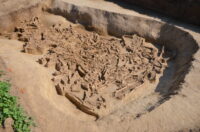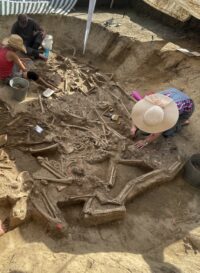 Archaeologists have discovered a unique Neolithic mass grave of headless bodies in Vráble, western Slovakia. The skeletons were found inside a defensive ditch of one of the largest Neolithic settlements in Central Europe.
Archaeologists have discovered a unique Neolithic mass grave of headless bodies in Vráble, western Slovakia. The skeletons were found inside a defensive ditch of one of the largest Neolithic settlements in Central Europe.
The Neolithic settlement dates to between 5250 and 4950 B.C. and contains three settlement areas covering more than 120 acres. Excavations and geophyisical surveys over the past seven years have revealed more than 300 long houses in the settlement, albeit built in different phases of occupation. Archaeologists believe about 50-70 houses would have been in use at any given time.
 In the last phase of occupation, one of the three settlement areas was fortified with at least one defensive ditch and a palisade. There were six entrances through the defensive perimeters into the settlement. Previous excavations have found individual graves in and around the ditch. This year, archaeologists found a long trench near one of the entrances to the settlement containing the skeletal remains of at least 35 people. The bodies appear to have been tossed in willy-nilly. They were found on their backs, on their stomachs, on their sides and arms and legs outstretched. The remains of men, women and children were buried in the grave, a disproportionate number of them were adolescents and young people when they died. There are some peri-mortem fractures. The skull of a one child and one mandible were the only bones from heads found in the grave.
In the last phase of occupation, one of the three settlement areas was fortified with at least one defensive ditch and a palisade. There were six entrances through the defensive perimeters into the settlement. Previous excavations have found individual graves in and around the ditch. This year, archaeologists found a long trench near one of the entrances to the settlement containing the skeletal remains of at least 35 people. The bodies appear to have been tossed in willy-nilly. They were found on their backs, on their stomachs, on their sides and arms and legs outstretched. The remains of men, women and children were buried in the grave, a disproportionate number of them were adolescents and young people when they died. There are some peri-mortem fractures. The skull of a one child and one mandible were the only bones from heads found in the grave.
Further tests are to be carried out to establish whether they were individuals who died separately, victims of an epidemic, or killed as part of cult ceremonies. They will also look for any genetic links between them, and whether the heads were forcibly removed or separation occurred only after decomposition of the body.
“Only then will we be able to answer several questions about the social categorisation of the [site’s] inhabitants, probably also about the emerging social inequality in the conditions of early agricultural societies, and perhaps even reconstruct the functioning or the causes of the demise of this vast settlement,” the director of the archaeological institute Matej Ruttkay said.